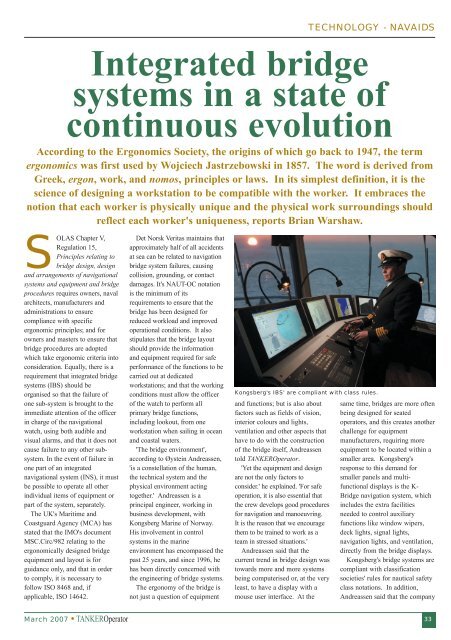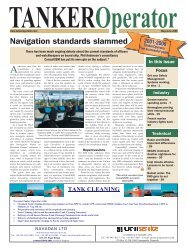Download - Tanker Operator
Download - Tanker Operator
Download - Tanker Operator
You also want an ePaper? Increase the reach of your titles
YUMPU automatically turns print PDFs into web optimized ePapers that Google loves.
TECHNOLOGY - NAVAIDS<br />
Integrated bridge<br />
systems in a state of<br />
continuous evolution<br />
According to the Ergonomics Society, the origins of which go back to 1947, the term<br />
ergonomics was first used by Wojciech Jastrzebowski in 1857. The word is derived from<br />
Greek, ergon, work, and nomos, principles or laws. In its simplest definition, it is the<br />
science of designing a workstation to be compatible with the worker. It embraces the<br />
notion that each worker is physically unique and the physical work surroundings should<br />
reflect each worker's uniqueness, reports Brian Warshaw.<br />
SOLAS Chapter V,<br />
Regulation 15,<br />
Principles relating to<br />
bridge design, design<br />
and arrangements of navigational<br />
systems and equipment and bridge<br />
procedures requires owners, naval<br />
architects, manufacturers and<br />
administrations to ensure<br />
compliance with specific<br />
ergonomic principles; and for<br />
owners and masters to ensure that<br />
bridge procedures are adopted<br />
which take ergonomic criteria into<br />
consideration. Equally, there is a<br />
requirement that integrated bridge<br />
systems (IBS) should be<br />
organised so that the failure of<br />
one sub-system is brought to the<br />
immediate attention of the officer<br />
in charge of the navigational<br />
watch, using both audible and<br />
visual alarms, and that it does not<br />
cause failure to any other subsystem.<br />
In the event of failure in<br />
one part of an integrated<br />
navigational system (INS), it must<br />
be possible to operate all other<br />
individual items of equipment or<br />
part of the system, separately.<br />
The UK's Maritime and<br />
Coastguard Agency (MCA) has<br />
stated that the IMO's document<br />
MSC.Circ/982 relating to the<br />
ergonomically designed bridge<br />
equipment and layout is for<br />
guidance only, and that in order<br />
to comply, it is necessary to<br />
follow ISO 8468 and, if<br />
applicable, ISO 14642.<br />
Det Norsk Veritas maintains that<br />
approximately half of all accidents<br />
at sea can be related to navigation<br />
bridge system failures, causing<br />
collision, grounding, or contact<br />
damages. It's NAUT-OC notation<br />
is the minimum of its<br />
requirements to ensure that the<br />
bridge has been designed for<br />
reduced workload and improved<br />
operational conditions. It also<br />
stipulates that the bridge layout<br />
should provide the information<br />
and equipment required for safe<br />
performance of the functions to be<br />
carried out at dedicated<br />
workstations; and that the working<br />
conditions must allow the officer<br />
of the watch to perform all<br />
primary bridge functions,<br />
including lookout, from one<br />
workstation when sailing in ocean<br />
and coastal waters.<br />
'The bridge environment',<br />
according to Øystein Andreassen,<br />
'is a constellation of the human,<br />
the technical system and the<br />
physical environment acting<br />
together.' Andreassen is a<br />
principal engineer, working in<br />
business development, with<br />
Kongsberg Marine of Norway.<br />
His involvement in control<br />
systems in the marine<br />
environment has encompassed the<br />
past 25 years, and since 1996, he<br />
has been directly concerned with<br />
the engineering of bridge systems.<br />
The ergonomy of the bridge is<br />
not just a question of equipment<br />
Kongsberg's IBS' are compliant with class rules.<br />
and functions; but is also about<br />
factors such as fields of vision,<br />
interior colours and lights,<br />
ventilation and other aspects that<br />
have to do with the construction<br />
of the bridge itself, Andreassen<br />
told TANKER<strong>Operator</strong>.<br />
'Yet the equipment and design<br />
are not the only factors to<br />
consider.' he explained. 'For safe<br />
operation, it is also essential that<br />
the crew develops good procedures<br />
for navigation and manoeuvring.<br />
It is the reason that we encourage<br />
them to be trained to work as a<br />
team in stressed situations.'<br />
Andreassen said that the<br />
current trend in bridge design was<br />
towards more and more systems<br />
being computerised or, at the very<br />
least, to have a display with a<br />
mouse user interface. At the<br />
same time, bridges are more often<br />
being designed for seated<br />
operators, and this creates another<br />
challenge for equipment<br />
manufacturers, requiring more<br />
equipment to be located within a<br />
smaller area. Kongsberg's<br />
response to this demand for<br />
smaller panels and multifunctional<br />
displays is the K-<br />
Bridge navigation system, which<br />
includes the extra facilities<br />
needed to control auxiliary<br />
functions like window wipers,<br />
deck lights, signal lights,<br />
navigation lights, and ventilation,<br />
directly from the bridge displays.<br />
Kongsberg's bridge systems are<br />
compliant with classification<br />
societies' rules for nautical safety<br />
class notations. In addition,<br />
Andreassen said that the company<br />
March 2007 • TANKER<strong>Operator</strong> 33

















